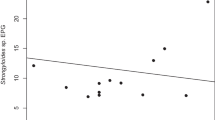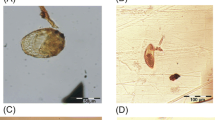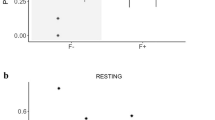Abstract
Trichuris spp. infect the majority of captive primate species along with an estimated 1049 million people worldwide, making it an important zoonosis [Stephenson, L. S., Holland, C. V., & Cooper, E. S. Parasitology, 121(Suppl.), S73–S95, 2000]. We investigated the efficacy of methods used to evaluate the prevalence of Trichuris spp. in 2 groups (n = 12) of socially housed Abyssinian colobus (Colobus guereza kikuyensis) at Paignton Zoo Environmental Park and the factors that may affect density. We collected individual and group fecal samples over 6 mo and estimated burden (egg counts/g of feces) of Trichuris spp. via the McMaster technique. Shedding was significantly higher in the afternoon than in the morning (matched-pairs t-test: t [5] = −4.46, p < 0.01) and in dominant adult male colobus (Spearman rank: r [5] = −0.94, p < 0.01; age: r [5] = 0.89, p < 0.05). Parasitological studies of zoo-housed primates can be a useful tool to explore factors that may affect burdens of Trichuris spp. in them.



Similar content being viewed by others
References
Abbott, D. H., Keverne, E. B., Bercovitch, F. B., Shively, C. A., Mendoza, S. P., Saltzman, W., Snowdon, C.T., Ziegler, T.E., Banjevic, M., Garland, T. Jr., Sapolsky, R.M. (2006). Are subordinates always stressed? A comparative analysis of rank differences in cortisol levels among primates. Hormones and Behavior, 43 (1), 67–82.
Bogea, T., Favre, T. C., Rotenberg, L., Silva, H. S., & Pieri, O. S. (1996). Circadian patterns of cercarial emergence in Schistosoma mansoni (Platyhelminthes: Digenea) from isolated Biomphalaria glabriata. Chronobiology International, 13, 93–101.
Bradley, J. E., & Jackson, J. A. (2004). Immunity, immunoregulation and the ecology of trichuriasis and ascariasis. Parasite Immunology, 26(11–12), 429–441.
Bundy, D. A. P., Lillywhite, J. E., Didier, J. M., Simmons, I., & Bianco, A. E. (1991). Age-dependency of infection status and serum antibody levels in human whipworm (Trichuris trichiura) infection. Parasite Immunology, 13, 629–638.
Dinh Son, V. (2002). Intestinal parasites of Macaca fascicularis in a Mangrove Forest, Ho Chi Minh City, Vietnam. Laboratory Primate Newsletter, 41, 9–10.
Doehring, E., Feldmeier, H., & Daffalla, A. A. (1983). Day-to-day variation and circadian rhythm of egg excretion in urinary schistosomiasis in the Sudan. Annals of Tropical Medicine and Parasitology, 77, 587–594.
Edwards, M. S., & Ullrey, D. E. (2001). Effect of dietary fiber concentration on apparent digestibility and digesta passage in non-human primates. II. Hindgut- and foregut-fermenting folivores. Zoo Biology, 18, 537–549.
Emikpe, B. O., Ayoade, G. O., Ohore, O. G., Olaniyan, O. O., & Akusu, M. O. (2002). Fatal trichuriosis in a captive baboon (Papio anubis) in Ibadan Nigeria: A case report. Tropical Veterinarian, 20, 36–39.
Fingerut, J. T., Zimmer, C. A., & Zimmer, R. K. (2003). Patterns and processes of larval emergence in an estuarine parasite system. Biological Bulletin, 205, 110–120.
Gillespie, T. R., Greiner, E. C., & Chapman, C. A. (2005). Gastrointestinal parasites of the colobus monkeys of Uganda. Journal of Parasitology, 91, 569–573.
Goossens, E., Dorny, P., Vercammen, F., & Vercrysse, J. (2004). A 12-month survey of the gastro-intestinal helminths of antelopes, gazelles and giraffids kept at two zoos in Belgium. Veterinary Parasitology, 127, 303–312.
Grunau, T., & Kuester, J. (2001). Dominance style in female guerezas (Colobus guereza Ruppell). Primates, 42, 301–307.
Hasegawa, H., Takayoshi, K., & Mulavwa, M. (1983). A parasitological survey on the faeces of pygmy chimpanzees, Pan paniscus, at Wamba, Zaire. Primates, 24, 419–423.
Hausfater, G., & Watson, D. F. (1976). Social and reproductive correlates of parasitic ova emissions by baboons. Nature, 262, 688–689.
Janagi, T. S. (1981). A report of gastro-intestinal helminth parasites found in Macaca fascicularis in peninsular Malaysia. Malaysia Applied Biology, 10, 99–100.
Knezevich, M. (1998). Geophagy as a therapeutic mediator of endoparasitism in a free-ranging group of rhesus macaques (Macaca mulatta). American Journal of Primatology, 44, 71–82.
Krebs, J., & Davis, N. (1997). Behavioural ecology: An evolutionary approach. Oxford, UK: Blackwell Publishing.
Loomis, M. R., & Wright, J. F. (1986). Gastric trichuriasis in a black and white colobus monkey. Journal of the American Veterinary Medical Association, 189, 1214–1215.
Maipanich, W., Visedsuk, K., Muennoo, C., Sanguankiat, S., Yoonuan, T., Pubampen, S., et al. (1998). Soil-transmitted helminths: Source and distribution of the infective stages in Southern Thailand. Journal of Tropical Medicine and Parasitology, 21, 31–36.
Maizels, R. M., & Kurniawan-Atmadja, A. (2002). Variation and polymorphism in helminth parasites. Parasitology, 125, S25–S37.
Martin, P., & Bateson, P. (1994). Measuring behaviour: An introductory guide (pp. 74–76). Cambridge, UK: Cambridge University Press.
Muriuki, S. M. K., Murugu, R. K., Munene, E., Karere, G. M., & Chai, D. C. (1998). Some gastro-intestinal parasites of zoonotic (public health) importance commonly observed in old world non-human primates in Kenya. Acta Tropica, 71, 73–82.
NRC (National Research Council) (2003). Feeding ecology, digestive strategies, and implications for feeding programs in captivity. In: Nutrient Requirement of Nonhuman primates (2nd ed.) (pp. 5–40). Washington, DC: The National Academies Press.
Phillippi, K. M., & Clarke, M. R. (1992). Survey of parasites of rhesus monkeys housed in small social groups. American Journal of Primatology, 27, 293–302.
Sapolsky, R. M. (2005). The influence of social hierarchy on primate health. Science, 308, 648–652.
Schmidt, G., & Roberts, L. (1985). Orders Trichurata and Dioctophymata: Aphasmidian parasites. In: Foundations of Parasitology (3rd ed.) (pp. 450–452). St. Louis: Times Mirror/Mosby College Publishing.
Sharma, V. K., & Chandrashekaren, M. K. (2005). Zeitgebers (time cues) for biological clocks. Current Science, 89, 1136–1146.
Shriram, G. N., Ramiah, K. D., Krishnamoorthy, K., & Sehgal, S. C. (2005). Diurnal pattern of human-biting activity and transmission of subperiodic Wuchereria bancrofti (Filariidae: Dipetalonematidae) by Ochlerotatus niveus (Diptera: Culicidae) on the Andaman and Nicobar Islands of India. American Journal of Tropical Medical Hygiene, 72, 273–277.
Stephenson, L. S., Holland, C. V., & Cooper, E. S. (2000). The public health significance of Trichuris trichiura. Parasitology, 121(Suppl.), S73–S95.
Taylor, L., Lessnau, R. G., & Lehman, S. M. (1994). Prevalence of whipworm (Trichuris) ova in two free-ranging populations of rhesus macaques (Macaca mulatta) in the Florida Keys. Florida Scientist, 57, 102–107.
Urquhart, J. W., Armour, J., Duncan, A. M., & Jennings, F. W. (1988). McMaster’s technique. In: Veterinary Parasitology (pp. 270–271). London, UK: Longman.
Acknowledgments
We thank the staff of Paignton Zoo for facilitating the study, notably Ghislaine Sayers, Sheona McGovern, and Kelly Elford. We also thank Neil Bemment, Julian Chapman, Lisa Doran, and Tony Dobbs.
Author information
Authors and Affiliations
Corresponding author
Rights and permissions
About this article
Cite this article
Melfi, V., Poyser, F. Trichuris Burdens in Zoo-Housed Colobus guereza . Int J Primatol 28, 1449–1456 (2007). https://doi.org/10.1007/s10764-007-9206-9
Received:
Revised:
Accepted:
Published:
Issue Date:
DOI: https://doi.org/10.1007/s10764-007-9206-9




